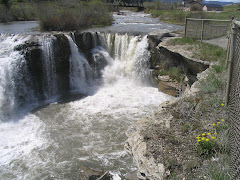On our way home Mark and I discussed the situation. The guest had been influenced by marketing practices of grocery stores and restaurant chains without a doubt. Now the question is: " what" did she think she was eating?
Was it Prime Rib or just "prime" meaning "good" beef ? Well in an effort to help sort out the differences in beef cuts served by commercial operations such as mine I thought I would give you a little information on the topic.
First off; restaurant cuts and retail cuts are two different beasts. The retail outlets of the country have thought up niffty names in an attempt to make their products more sell able and so they can charge more . The likes of "standing rib roast" and "sirloin tip roast" don't exist in my world. We buy beef in much lager cuts, in fact primal cuts are what I purchase. They have no fancy adjectives to describe them or their tenderness. They just tell me what part of the beasties they come from.
What does all this mean you ask? Well it means that on my menu I have 3 types of what would be considered "Roast Beef" and with a little help you can tell which one you are being served just by looking at it on my cutting board.
1. Roast Beef - I use round roasts - now that does not mean that the roast is round like a ball. It is the primal cut from the leg of the animal - it may be an inside round or an outside round - depends on what is the best price that week. If they had a bone the inside would be one side ,the outside would be another and the whole thiing with the bone would be a hip of beef. Like all our roasts we season them and then roast them slow ( about 275 F and no lid on it please- if you put a lid on it you are steam or braising it not roasting it) It is an irregular shape and has grain running in several directions. The round is not a particular tender cut of beef but if you treat it well it will treat you well. Two most important things - Cook it slow and do not over cook it. When you carve it always carve across the grain and in thin slices.
It looks something like this.
or cooked
its tasty and lean and what 80% of our roast beef banquets are. (We used 77 cases last year- thats 144 roasts)
2. Roast Striploin : The second type we roast is the striploin sometimes called New York Striploin. This is the same piece that a New York steak is cut from but we roast them whole. If you think of a T bone steak one side of the bone is the tenderloin or fillet the other is the New York. The grain is fine and runs all the same direction making it really easy to carve. Again we roast it slow and never cooking past medium rare. ( those that must have well done can get it from the end cuts) Its by far my favorite form of roast beef . You can spot it on a buffet line by its uniform rectangular shape and the thin fat cap on it. It looks like this
3. The Prime Rib- What many consider the King of roast beef. No its not a standing rib roast ( although that is what retailers sell pieces of prime rib as) it's not a cross rib roast ( thats just a messy thing and a way for retailers to get more for a piece of meat than its worth) It's an 8 bone ( although you rarely see the bones on the buffet) primal cut that is a wonder all it's own. This is the one we done for the Teck coal Christmas parties. Boarder Lumber had it this year and what I would recommend to anyone that wants to impress there guests. It does cost more but its worth it. We roast it slow ( see the pattern here) with the bones and the fat cap on then remove them for service. It has a fine grain that runs all the same way and can be carved as thick as you like which makes it really easy to serve and the one that I train new carvers on. On the buffet it is the easiest to spot ( it just lies there with its flat bottom, thats the side the bones were on, and its rounded top tapering to its little tail.) Don't ask for it with no fat ( it doesn't come that way, and thats why it has sooooo much flavour) but do take it done anywhere up to medium. ( this helps to melt the fat and make it taste better) It looks like this:
raw
cooked
and on your plate
Well I hope this dispelled some of the confusion around the mighty "Alberta Roast Beef"



Wow, that was an excellent roast beef that you prepared. What's your secret? When I prepare my own version of this dish, I inject a special, homemade sauce into the roast in order to allow the meat to absorb the different flavors.
ReplyDeleteHi NY Catering
ReplyDeleteTheres not much of a secret to it. I use AAA Alberta Beef season it with a spice mix( seasoning salt,pepper,garlic,some herbs etc) and then roast it slow ( 250-275 F) uncovered until its internal temperature is about 120-125 F and always let it rest at least 1/2 before I carve it.